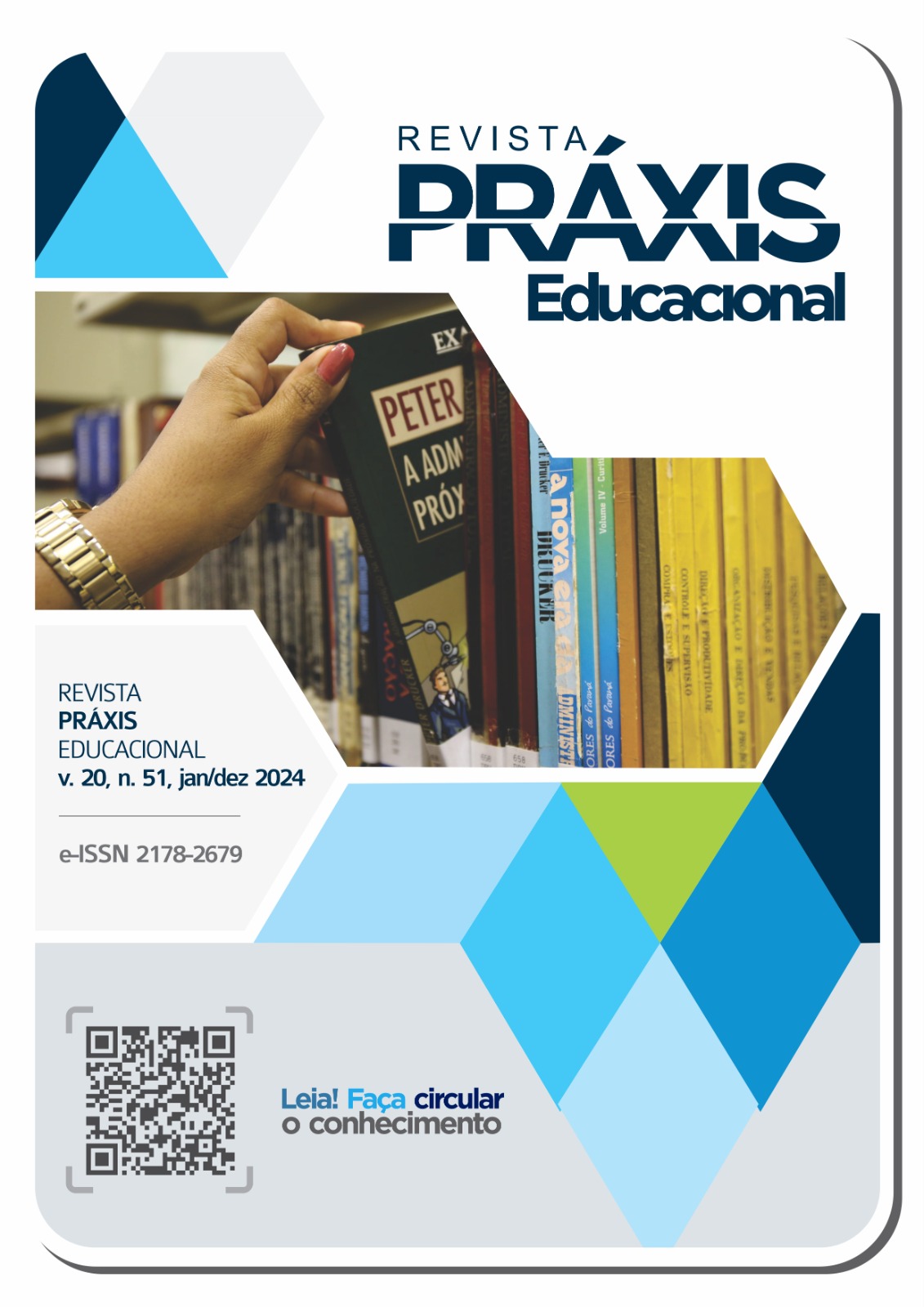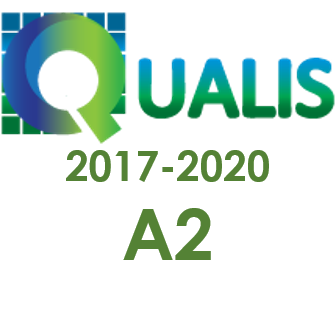The space of visual arts in childhood education: the municipal curriculum base of Guanambi – BAnicipal curriculum base of Guanambi – BA
DOI:
https://doi.org/10.22481/praxisedu.v20i51.13508Keywords:
child education, public school, visual arts, pre schoolAbstract
This article is the result of the research “Between conversations and visualities: practices in Visual Arts in Early Childhood Education in public institutions in the city of Guanambi-BA”, developed in the Associated Postgraduate Program in Visual Arts UFPB/UFPE, in the research line Educational Processes in Visual Arts, defended in 2023. The clipping, presented here, focuses on the documentary analysis of the Municipal Curriculum Base of Guanambi (BMCG), published in 2020, prepared in accordance with the current national and state public policies, in addition to a careful consultation with the local community. In this analysis, it was specifically observed the notes referring to the Visual Arts in Kindergarten/preschool and it was verified that the document recognizes the Visual Arts as one of the children's languages, bearer of its own contents, however, in its text , it is still possible to perceive gaps, which need to be better understood, to which we reaffirm the indispensable and continuous aesthetic/artistic nourishment of the faculty and managers of the institutions, in order to allow the empirical actions to be established as propositions, which enhance the presence of the Visual Arts in establishments in a critical way that meets the creative needs of children and also the adults who are there.
Downloads
Metrics
References
ALBANO, Ana Angélica. Agora eu era o herói: imaginação e expressão artística na primeira infância. Revista Digital do LAV, Santa Maria, v. 11, n. 2, p. 09 – 19, mai./ago. 2018. DOI: 10.5902/1983734833895 Disponível em: https://periodicos.ufsm.br/revislav/article/view/33895. Acesso em: 17 fev. 2022.
ALBANO, Ana Angélica. Por uma pedagogia da infância através da arte. In: CAMPOS, Káti a Patrício Benevides, OLIVEIRA, Maria das Graças, BOITO, Crisliane (org.). Infância, arte e produção cultural. Estância Velha: Z Multi, 2021. p. 17 – 31. Disponível em:
https://www.zmultieditora.com.br/flipbook/deploy/pdf/e02f01362ec1ce32eacd882ba2dfcdb110da2678.pdf Acesso em: 17 fev. 2022.
BAHIA. Documento curricular referencial da Bahia para educação infantil e ensino fundamental. Secretaria de Educação do Estado da Bahia. Rio de Janeiro: FGV, 2019.
BARBIERI, Stela. Interações: onde está a arte na Infância? São Paulo: Blucher, 2012.
BARBOSA, Ana Mae Tavares; CUNHA, Fernanda Pereira da (org.). A Abordagem Triangular no ensino das artes e culturas visuais. São Paulo: Cortez, 2010.
BRASIL, Ministério da Educação. Parâmetros Curriculares Nacionais para o Ensino Fundamental. Brasília, DF: MEC/SEF, 1997.
BRASIL. Ministério da Educação. Diretrizes curriculares nacionais para a educação infantil. Secretaria de Educação Básica. Brasília, DF: MEC/SEB, 2010.
BRASIL. Ministério da Educação. Base Nacional Comum Curricular. Brasília, DF: MEC, 2017.
DEWEY, John. Arte como experiência. São Paulo: Martins Fontes, 2010.
FERRAZ, Maria Heloisa Correa de Toledo; FUSARI, Maria Felisminda de Rezende e. Metodologia do Ensino de Arte. São Paulo: Cortez, 1993.
FREITAS, Ana Cláudia de Oliveira; VIDAL, Fabiana Souto Lima. Entre Olhares... As imagens que habitam nossas escolas!. Existências In: ENCONTRO NACIONAL DA ANPAP. 31., 2022, Recife. Anais [...]. Recife: on-line, 2022. p. 1-21. Disponível em: http//www.evem3.com.br/anais/31ENANPAP2022/4975593-ENTRE-OLHARES-AS-IMAGENS-QUE-HABITAM-NOSSAS-ESCOLAS. Acesso em: 21 nov. 2022.
GUANAMBI. Prefeitura Municipal. Secretaria Municipal de Educação. Centro de Treinamento Pedagógico. Base Municipal Curricular de Guanambi para Educação Infantil, Ensino Fundamental e Modalidades de Ensino – Departamento de Ensino e Apoio Pedagógico. Guanambi: Secretaria Municipal de Educação, 2020.
GUIMARÃES, Leda. Arte, design e cultura visual do povo: uma conversa entre mulheres. Revista GEARTE, Porto Alegre, v. 5, n. 1, p. 117 – 129, jan./abr. 2018. Disponível em: https://seer.ufrgs.br/index.php/gearte/article/view/74969. Acesso em: 01 out. 2021.
IAVELBERG, Rosa. Arte, infância, formação docente e cultura na escola. In: CUNHA, Susana Rangel vieira da, CARVALHO, Rodrigo Sabala de (org.). Arte Contemporânea e Educação Infantil: crianças observando, descobrindo e criando. 2. ed. ver. e ampl. Porto Alegre: Zouk, 2022. p. 115-124.
LANIER, Vincent. Devolvendo arte à arte-educação. In: BARBOSA, Ana Mae Tavares (org.). Arte-educação: leitura no subsolo. 7. ed. São Paulo: Cortez, 2008. p. 43-55.
LÜDKE, Menga; ANDRÉ, Marli Eliza Dalmazo Afonso de. Pesquisa em Educação - Abordagens Qualitativas. 2. ed. Rio de Janeiro: E.P.U., 2018.
OSTETTO, Luciana Esmeralda. Formação, pesquisa e prática docente pelos territórios da arte: (re)conectar sensibilidades, (re)inventar linguagens. In: OSTETTO, Luciana Esmeralda; SILVA, Greice Duarte de Brito; BIBIAN, Simone (org.). Educação Infantil, formação e prática docente nas tramas da arte: diálogos com Anna Marie Holm e Vea Vecchi. Curitiba: Appris, 2021, p. 23-35.
PEREIRA, Marcos Villela. O limiar da experiência estética: contribuições para pensar um percurso de subjetivação. Pro-Posições, Campinas, v. 23, n. 1, v. 67, p. 183-195, jan./abr. 2012. Disponível em: https://www.scielo.br/j/pp/a/sQFMpDZ3pfqhFYjwQVmLVQL/?lang=pt. Acesso em: 02 ago. 2021.
STACCIOLI, Gianfranco. Infância e suas linguagens. In: GOBBI, Marcia Aparecida; PINAZZA, Mônica Apezzatto (org.). Infâncias e suas linguagens. São Paulo: Cortez, 2015, p. 95-126.
Downloads
Published
How to Cite
Issue
Section
License
Copyright (c) 2024 Práxis Educacional

This work is licensed under a Creative Commons Attribution 4.0 International License.
You are free to:
Share - copy and redistribute the material in any medium or format; Adapt - remix, transform, and build from the material for any purpose, even commercially. This license is acceptable for Free Cultural Works. The licensor cannot revoke these freedoms as long as you follow the terms of the license.
Under the following terms:
Attribution - You must appropriately give credit, provide a link to the license, and indicate if any changes have been made. You may do so in any reasonable way, but not in a way that suggests that you or your use is endorsed by the licensor.
There are no additional restrictions - You cannot apply legal terms or technological measures that legally restrict others to make any use permitted by the license.










